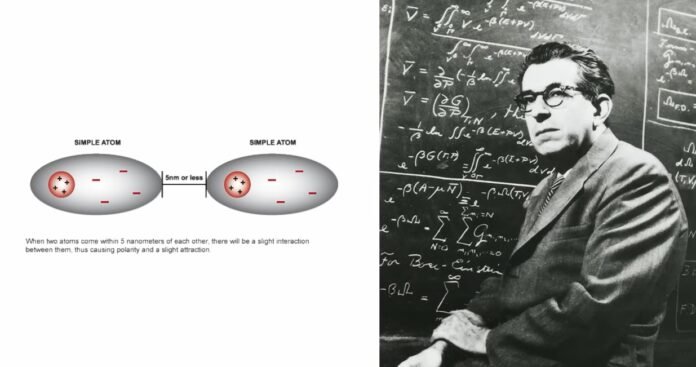The field of physics known as quantum mechanics, which describes how matter and energy behave at the smallest scales, is rife with fascinating and frequently paradoxical occurrences. The Casimir effect, which describes a force that develops between two uncharged metal plates that are put very close to one another in a vacuum, is an example of such a phenomenon. The Casimir effect has been detected in experiments despite its ostensibly esoteric nature, and it has significant ramifications for our comprehension of quantum mechanics and its prospective applications in areas like nanotechnology and energy harvesting.
Casimir Effect
Hendrik Casimir, a Dutch physicist, made the first prediction of the Casimir effect, a quantum mechanical phenomena, in 1948. The theory predicts that when two uncharged metal plates are placed very close to one another in a vacuum, a force will push the plates in the direction of each other. The quantum electromagnetic field fluctuates even in the absence of matter, which gives rise to this force.
Space is thought to be absolutely devoid of all energy and matter in classical physics. In contrast, unoccupied space is viewed in quantum physics as a sea of virtual particles that are continually appearing and dissipating. Real particles, like the metal plates in the Casimir effect, can interact with these virtual particles and feel a force as a result.
The Casimir effect is a result of the likelihood that virtual particles with shorter wavelengths, like those in the ultraviolet range, will be discovered close to a metal surface as opposed to those with longer wavelengths, like those in the infrared region. The potential wavelengths of virtual particles that can exist between two metal plates are constrained when they are brought close to one another. As a result, there are more virtual particles outside the plates than inside them, which pushes the plates closer together by creating a force.
Observation of Casimir Effect
Steve K. Lamoreaux of the Los Alamos National Laboratory made the first experimental observation of the Casimir effect in 1996. In his experiment, two parallel plates were brought very close to one another while floating in a vacuum chamber. A torsion balance was used to quantify the force exerted between the plates, which allowed for the detection of the weak force despite its small size.
The Casimir effect has been seen in numerous additional systems since Lamoreaux’s original experiment, including spherical and cylindrical geometries. The validity of the idea has been further supported by these observations, which have also allowed researchers to more thoroughly examine the effect.
The Casimir Effect in Practice
Numerous situations in which the Casimir effect has been experimentally seen. In one of the earliest tests, two parallel metal plates that were put near to one another were used. The Casimir effect was established by measuring the amount of force necessary to separate the plates.
The Casimir effect has also been researched in less ideal conditions, such as when the plates are not completely flat or the vacuum between the plates contains flaws.
Applications of the Casimir Effect
Uses for the Casimir Effect
- The Casimir effect has many useful applications in numerous branches of science and industry, despite initially appearing to be solely an academic curiosity.
- One potential technique for producing micro- and nano-scale mechanical devices, such as actuators and switches, is the Casimir effect.
- The Casimir effect has also been utilized in experiments to examine the characteristics of unusual particles like axions and dark matter, as well as to gauge the intensity of the electromagnetic force at close ranges.
- The Casimir effect has also been suggested as a way to generate energy, though its viability in practice is still up for debate.
The Casimir Effect and the Nature of Space and Time
The Casimir effect is intriguing from a theoretical, philosophical, and conceptual perspective in addition to being interesting practically. The Casimir effect specifically raises concerns regarding the nature of space and time as well as the compatibility of general relativity and quantum physics.
The Casimir effect poses several important concerns, one of which is why the vacuum energy connected to the fields between two plates is distinct from the vacuum energy outside the plates. Due to this energy disparity, it is possible that the vacuum does not exist as a homogenous, isotropic object but rather has a structure and characteristics that are dependent on the presence of other objects.
Recommended Articles:
CAPACITOR TYPES: Classification, Types, Application, Factor, Common and Value
Capacitors in Parallel: Introduction, Applications, and Combination
Carbon Resistors: Introduction, Components, Symbol, Working and Applications
Carnot Engine: Introduction, Theorem, Cycle and Steps
Carnot’s Theorem: Introduction, Efficiency, Reversible, Limitations and Applications
It predicts that when two uncharged metal plates are placed very close to one another in a vacuum, a force will push the plates in the direction of each other. 1948 1996 The two applications of Casimir Effect are given as below : used for producing micro- and nano-scale mechanical devices Casimir Effect FAQs
What do you mean by Casimir effect?
When was the first time the Casimir effect was predicted?
When was the first time the Casimir effect was observed experimentally?
Enlist any two applications of Casimir effect?
It has also been utilized in experiments to examine the characteristics of unusual particles like axions and dark matter
